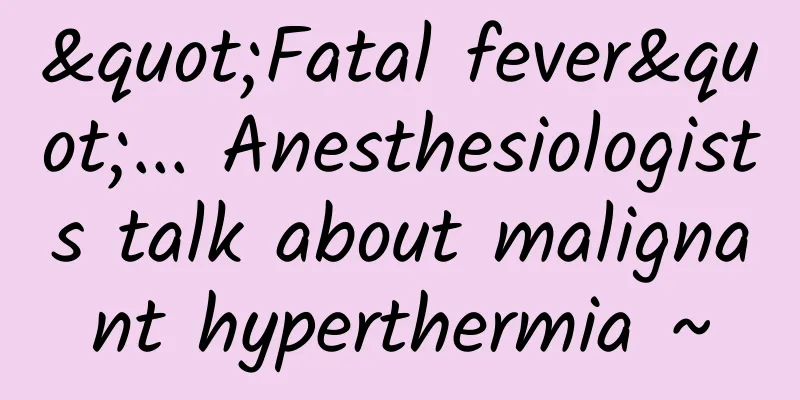"Fatal fever"... Anesthesiologists talk about malignant hyperthermia ~

|
In 2021, the Chinese Expert Consensus Working Group on the Prevention and Treatment of Malignant Hyperthermia published the "Chinese Expert Consensus on the Prevention and Treatment of Malignant Hyperthermia (2020 Edition)" in the Chinese Journal of Anesthesiology, which elaborated on the definition, clinical manifestations, differential diagnosis, and treatment of malignant hyperthermia, providing a basis for guiding clinical work. Malignant hyperthermia (MH) is a clinical syndrome with autosomal dominant inheritance as the main mode of inheritance. Its typical clinical manifestations often occur after the use of volatile inhalation anesthetics. According to literature reports, the incidence of MH under general anesthesia in children (1/15000) is higher than that in adults (1/50000), and it is more common in males than in females. As early as the 1960s, the mortality rate of MH was as high as 90%. With the continuous deepening of MH-related research, the continuous improvement of diagnosis and treatment levels, and the popularization of targeted therapeutic drugs, the mortality rate of MH has not been improved. According to incomplete statistics, the mortality rate of MH in my country is still as high as 73.5%. Next, let us deepen our understanding of MH through a comic story. His name is Mu Hao (MH), he is eight years old, 130 cm tall and weighs 24 kg. He lives a happy life and is a carefree child. One day, Xiao Hao suddenly had abdominal pain and felt a lump in the right abdomen. The pain was unbearable, so his parents sent him to the hospital for treatment. After diagnosis by his handsome doctor brother, it was confirmed that Xiaohao had an incarcerated hernia and needed surgical treatment. Complete pre-operative examinations: blood routine, coagulation II, electrocardiogram... The anesthesiologist explained the anesthesia method and related complications to Xiaohao and his mother. As Xiaohao's guardian, his mother signed the informed consent form. The operation went smoothly, but when it was about to end, the anesthesiologist found that Xiao Hao's: ① end-tidal carbon dioxide suddenly increased; ② body temperature rose sharply; ③ heart rate also gradually increased. Xiaohao's condition continued to deteriorate: ① The electrocardiogram showed ventricular tachycardia; ② The body temperature was as high as 42°C; ③ Myotonia occurred. Based on Xiao Hao's clinical manifestations, the anesthesiologist highly suspected malignant hyperthermia... Based on the MH clinical score, the anesthesiologist quickly made a judgment... Multidisciplinary collaboration, time is life! Rapid implementation of multi-department rescue... Use multiple methods of physical cooling: ice packs, ice salt water... Within 10 minutes, infuse dantrolene sodium for injection... After timely multidisciplinary treatment, Xiaohao's vital signs gradually stabilized. Later, after genetic testing and caffeine-halothane isolated skeletal muscle contraction test, he was diagnosed with malignant hyperthermia. Xiao Hao was safely transferred back to the ward~ The anesthesiologist informed the ward nurse of the changes in the patient's condition during the operation and instructed that dantrolene sodium should still be infused intravenously at a rate of 0.25 mg·kg-1·h-1 for 24 hours and that changes in vital signs should continue to be monitored. After 24 hours, Xiao Hao's condition was stable: ① core body temperature 38 ℃; ② CK continued to decrease; ③ no myoglobinuria; ④ no muscle stiffness; the nurse stopped using dantrolene sodium as ordered by the doctor. The anesthesiologist visits the child after surgery, checks the medical records, inquires about monitoring data, temperature records, and test results, and instructs the nurse on follow-up monitoring priorities. A week later, Mu Hao recovered and was discharged from the hospital smoothly! MH has a low incidence rate, but a high mortality rate. Mu Hao developed malignant hyperthermia and received timely treatment, and he is now safe! Patient: After reading the comics, I realized how terrible malignant hyperthermia is! I want to know more. Can I ask the doctor a few more questions? Anesthesiologist: Sure. Just ask. Anesthesiologist: You’re welcome, Xiaohao. Tell your family. If you get sick, remember to tell the doctor about your family medical history! I wish you a happy life and healthy growth! At present, anesthesiologists are trying to study the rapid clinical diagnosis method of malignant hyperthermia and carry out molecular genetic research through multidisciplinary cross-collaboration. If we want to completely conquer malignant hyperthermia, scientists still need to carry out in-depth scientific research, but we firmly believe that the "true face" of MH will become clearer and clearer! |
Recommend
How long does it take for the menstrual period to end?
Women need to stay in confinement after giving bi...
Women should never use paper to wipe this place
Adolescent girls tend to neglect private hygiene....
Scientific methods for preparing for pregnancy of girls
Although people's views on gender are no long...
Occasional swelling in the anus during early pregnancy
Women will feel a little uncomfortable in the ear...
Why do my colleagues like to tell tales? Why do my colleagues like to tell tales?
The workplace is also a small world of swords and...
How to maintain the uterus after uterine curettage?
We all know that the uterus is the most important...
How to benefit the chest
Big breasts and plump buttocks are usually used t...
Can women use moxibustion during menstruation?
Many people do moxibustion every day. Moxibustion...
Is it normal to have brown discharge at 11 weeks pregnant?
During pregnancy, menstruation will stop, but vag...
What are the dangers of moderate fatty liver in women?
The problem of fatty liver is relatively serious ...
AppData: As of December 2011, Facebook mobile app MAU exceeded 300 million
According to AppData data, Facebook's iOS and...
My butt got bigger after pregnancy
Pregnant mothers all know that many subtle change...
Does menstruation count as one day if there is only blood?
Menstruation is a normal physiological phenomenon...
[Food Safety Science] Different types of food have different frozen shelf lives!
Frozen dumplings, frozen meat... Many people have...
Can I eat bacon during menstruation?
Menstruation is a very important festival for wom...









